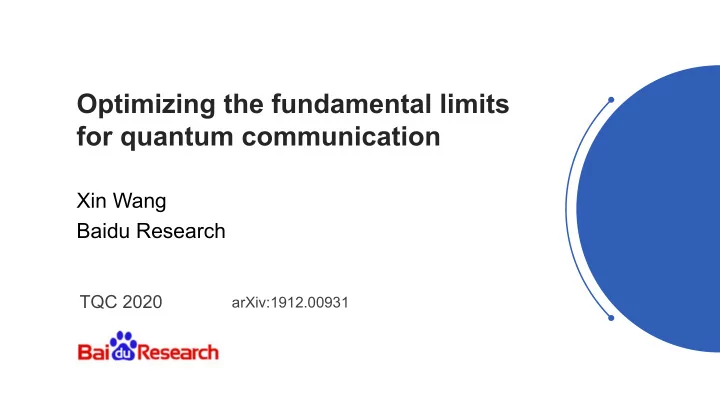

Optimizing the fundamental limits for quantum communication Xin Wang Baidu Research TQC 2020 arXiv:1912.00931
Quantum capacity of a quantum channel l The quantum capacity of a channel N is the number of qubits, on average, that can be faithfully transmitted with each use of N. l The task is to protect quantum information from errors due to quantum noise (or simulate a noiseless quantum channel). N Encoder Decoder l Quantum capacity theorem is established by (Lloyd, Shor, Devetak 97- 05) & (Barnum, Nielsen, Schumacher 96-00) 1 m Q ( ) lim I N N c m m c I ( N ): max H ( N ( )) H N ( ) l Coherent information c
Difficulty of estimating Q(N) • Q(N) does not have a single-letter formula. • Regularization is necessary in general [Cubitt el.al, 2014]. • Q(N) is not additive in general [Smith, Yard, 2009]. • Even for qubit depolarizing channel ( ) : (1 p ) p Tr( ) / 2 I D p we do not know its quantum capacity.
Many methods to estimate Q(N) • To evaluate Q(N), substantial efforts have been made in the past two decades. • Bounds for general channels • Partial transposition bound (Holevo, Werner'01) • Rains information (Tomamichel, Wilde, Winter'14) • max-Rains bound (Wang, Fang, Duan'18) • Geometric Rényi bound (Fang, Fawzi'19) • ... • Bounds for depolarizing channel • Symmetric Side Channels (Smith, Smolin, Winter'08) • Approximate degradable channels (Sutter et al.'17) • Degradable decomposition (Leditzky, Datta, Smith'18) • Quantum flag bound (Fanizza, Kianvash, Giovannetti'19)
Main messages • New single-letter fundamental limits for entanglement distillation, quantum communication, and private communication. • Optimize the extended channel whose quantum capacity is easy to estimate. • Improved bounds for several fundamental quantum channels.
Main result 1 - Bound for distillable entanglement Bob Alice Bob Alice m weaker m n than Tr n AB with AB F ABF ABF • Apply the converse bound via approximate degradability bound Leditzky et al. 2017 where η (ρ) is degradability parameter. • How can we further optimize over the extended states? Parametrize the extended state! • Consider the sub-state decomposition AB AB AB function s can be efficiently computed.
Main result 2 - new upper bound for depolarizing channel • One of the most important channels, useful in modelling noise for quantum hardware. D ( ) : (1 p ) p Tr( ) / 2 I p • However, its quantum capacity remains unsolved despite substantial efforts. • Q(N) of a teleportation-simulable N = one-way distillable entanglement of its Choi state . (Bennett et al'96) (1 p ) pI / 4 • The Choi state of the qubit depolarizing channel D p • Applying our bound on one-way distillable entanglement Q inf s ((1 p ) , pI / 4, ) D p 0 1 • The final step is to search over α.
Application 1 - depolarizing channel • We establish improved upper bounds on Q(N) of the depolarizing channel. Low noise Intermediate noise
Upper bounds via flags and degradability • For a general quantum channel, we could deploy the quantum flags (Fanizza et al.'19). k • For a channel with CP map decomposition, N N j j 0 k (1) Q ( ) inf Q ( ) f ( ( )) N N N ( ) ( ) N N with j j , , j 0 0 k • We could take a more specific structure • Q1 of degradable extended channels can be efficiently computed (Fawzi & Fawzi'17) Difference between our method and the quantum flag method in Fanizza et al.'19 1. We parametrize flags and then optimize over them! 2. We consider a general CP map decomposition.
Application 2 - Generalized admplitude damping channel • The GAD channel is one of the realistic sources of noise in practice. † † † † ( ) A A A A A A A A A y N , 1 1 2 2 3 3 4 4 A 1 N (|0 0| 1 y |1 1|) A y (1 N ) |0 1| A N ( 1 y |0 0| |1 1|) A yN |1 0| 1 2 3 4 • We introduce the extended channel • By numerics and analysis, we find that α = 0 would be the best choice. • We further show that
Application 2 - Generalized admplitude damping channel • Our bound is tighter than previous upper bounds in (Khatri et al.'19) via the data processing approach (Khatri et al.'19) and Rains information (Tomamichel'14).
Application 3 - BB84 channel Independent bit and phase error Smith and Smolin'08 Sutter et al.'2017 improved the bound in the region 0<p<0.0002 We have established improved bounds for this channel.
Summary l Single-letter upper bounds on entanglement distillation + quantum/private communication. l The key idea is to optimize the extended channels. l The extended or flagged channel structure is quite useful and can be combined with other techniques of channel capacity estimation. l Improved upper bounds on the quantum/private capacities of depolarizing channel, BB84 channel, generalized amplitude damping channel. Outlook l It will be interesting to look at the interaction between extended channels and the degradable and anti-degradable decomposition of channels (Leditzky et al.'18). l Apply the techniques in this work to classical capacity or other resource theories.
Thanks for your attention! See arXiv:1912.00931 for more details. Slides available at www.xinwang.info
Recommend
More recommend